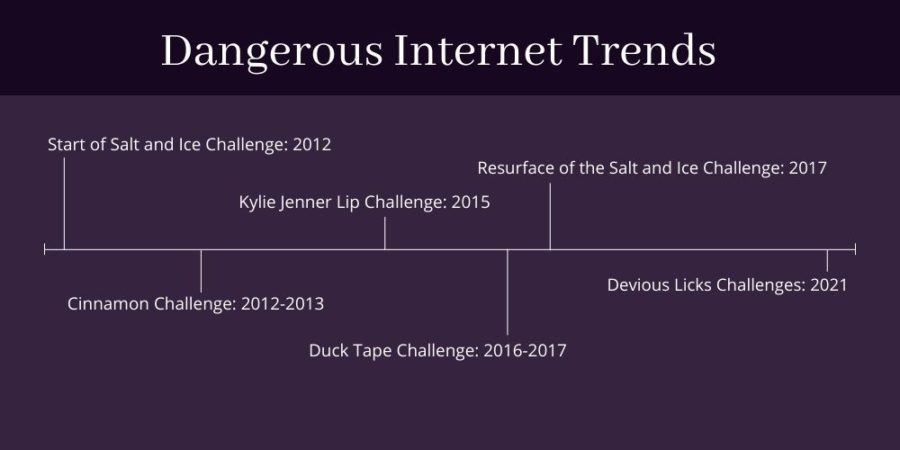Social media challenges get out of hand
Not every dangerous challenge has happened in the last year and on TikTok, however since the internet became more accessible more trends have occurred.
December 11, 2021
Internet trends, like dumping a big bucket of cold water and ice on yourself and standing as still as possible in a freeze frame while a friend records, have happened since the early 2010s, but with the rise of apps like TikTok, whose user base is 60% 16- to 24-year-olds as stated by Wallaroo, more students are seeing and trying internet trends. One of the most recent trends went under the name “devious licks”.
“I thought it was really funny when I first saw it on TikTok,” senior Isis Richards said. “But then when it started happening [at Chantilly], and people started stealing soap in the middle of a pandemic, I was like, oh, okay, I see the problem.”
The “devious licks” main goal was for a student to steal school property or just any item in the school building, and post it on TikTok, labeling said stolen item as a ‘lick’. Stealing school property or any items while in school can cause a student to receive disciplinary actions or a criminal record.
“I don’t see why anyone would record their face.” Richards said. “I feel like that’s a very dumb decision so I don’t think people thought that one through.”
Another dangerous challenge that started on YouTube was the salt and ice challenge, where participants were encouraged to put salt on their arm then place an ice cube over top. Dignity Health states this causes a chemical reaction similar to frostbite. The goal is to last the longest while receiving these burns. YouTube’s Cinnamon challenge, (where the participant swallows a spoonful of cinnamon powder) and Instagram’s Kylie Jenner Lip challenge (a glass cup is placed over their lips, than sucks the air out, causing the participants lips to swell in size from the suction) are examples of other trends that cross the line between good fun and downright dangerous.
“These trends will exist as long as kids get bored,” English teacher Bobby Nelson said. “So yes, they’re likely to continue in altered forms.”
It’s quite easy to see how a trend is dangerous but how it gets there is a different story.
Without the internet, challenges and trends were localized to specific places because it was word of mouth that got them to travel. However with apps like TikTok and platforms like YouTube, challenges are able to reach a far wider radius of people. It’s all in the algorithm; the more likes or views a video gets the more the algorithm recommends it to people.
“They all kind of stem from the same idea we want to stand out, but we also want to be accepted by our peers,” psychology teacher Matthew Miles said. “So, we do what everybody else is doing but we escalate it slightly.”
According to Psychology Today, whenever the brain sees something surrounded by popularity, it surrounds it with value. Unlike adults, adolescents haven’t fully developed the ability to understand long term consequences of their actions, making these challenges dangerous.
Once these challenges start it’s hard to get them to stop, both school officials and law enforcement condemning these crimes is considered ineffective. Psychology Today also stated that a teenager’s frontal lobe (the section of the brain that controls reasoning) isn’t fully developed, giving adolescents the unconscious idea that they are invincible.
“I took from the ‘devious licks’ trend that counterculture and anti-establishment memes are rearing their head again,” Nelson said. “Pranks have always been a part of school culture, so I’m not surprised to see something like devious licks happen.”
When students are denied the positive reinforcement they originally sought out when attempting these dangerous trends, it prevents them from trying it again.
“For the behavior to stop it has to be generally lame,” Miles said. “If a kid were to rip something off the wall and most kids respond in a way that’s negative, like that was really stupid, now we don’t have a place to go to the bathroom. Right, that’s when the trend stops right.”
As well as student policing, adults getting involved and trying to “get hip with the kids” will definitely put an end to internet challenges.
“If you want to regulate TikTok then get adults on there, start having teachers post assignments on TikTok,” Miles said. “Anytime you want to kill a social media trend, have older people start doing it, and now, it’s no longer the unique language of the adolescent.”
Internet challenges can be a fun and an engaging way to spend time with friends; however, when a trend affects a person’s safety and their future, not only will it harm them, but also the peers around them. Each action that is shared, especially on the internet, like locking the school bathrooms to prevent theft, and putting child locks on Tide Pod boxes, can have a ripple effect that only inconveniences everyone else.






